Precipitation-Related Atmospheric Nutrient Deposition in Farmington Bay: Analysis of Spatial and Temporal Patterns
Abstract
1. Introduction
1.1. Atmospheric Deposition of Nutrients into Lakes and Reservoirs
1.2. Farmington Bay of the Great Salt Lake
1.3. Study Overview
2. Study Area, Data, and Methods
2.1. Farmington Bay Area
2.2. AD Sample Collection
2.3. Precipitation Data Source
2.4. Wind Data Sources
2.5. Air Quality
2.6. Load Calculation
2.7. Analysis Overview
3. Data Analysis
3.1. Precipitation Data Analysis
3.2. Wind Data Analysis
3.3. Nutrient Concentration Data
4. Results and AD Load Estimates
4.1. Annual Load Rates
4.2. Nutrient Loads and Air Quality Analysis
4.3. Spatial and Temporal Distribution of AD Loads
5. Discussion
5.1. Spatial and Temporal AD Load Variation
5.2. Relation to Previous Studies
6. Conclusions
Supplementary Materials
Author Contributions
Funding
Data Availability Statement
Acknowledgments
Conflicts of Interest
Abbreviations
| AD | Atmospheric Deposition |
| TP | Total Phosphorus |
| OP | Orthophosphate |
| TN | Total Nitrogen |
| HAB | Harmful Algal Bloom |
| DIN | Dissolved Inorganic Nitrogen |
| Mg | Megagram (1 Mg = 1 metric ton = 1000 kg) |
| µm | Micrometer |
| PM2.5 | Particulate Matter with diameter less than 2.5 μm |
| PM10 | Particulate Matter with diameter less than 10 μm |
| IDW | Inverse Distance Weighting |
| EPA | Environmental Protection Agency |
| CoCoRaHS | Community Collaborative Rain, Hail, and Snow Network |
| GHCN | Global Historical Climatology Network |
| MCHD | Meteorological and Climatological Historical Database |
| UGS | Utah Geological Survey |
| NED | National Elevation Dataset |
| NOAA | National Oceanic and Atmospheric Administration |
| MDPI | Multidisciplinary Digital Publishing Institute |
Appendix A. Wind Rose Plots
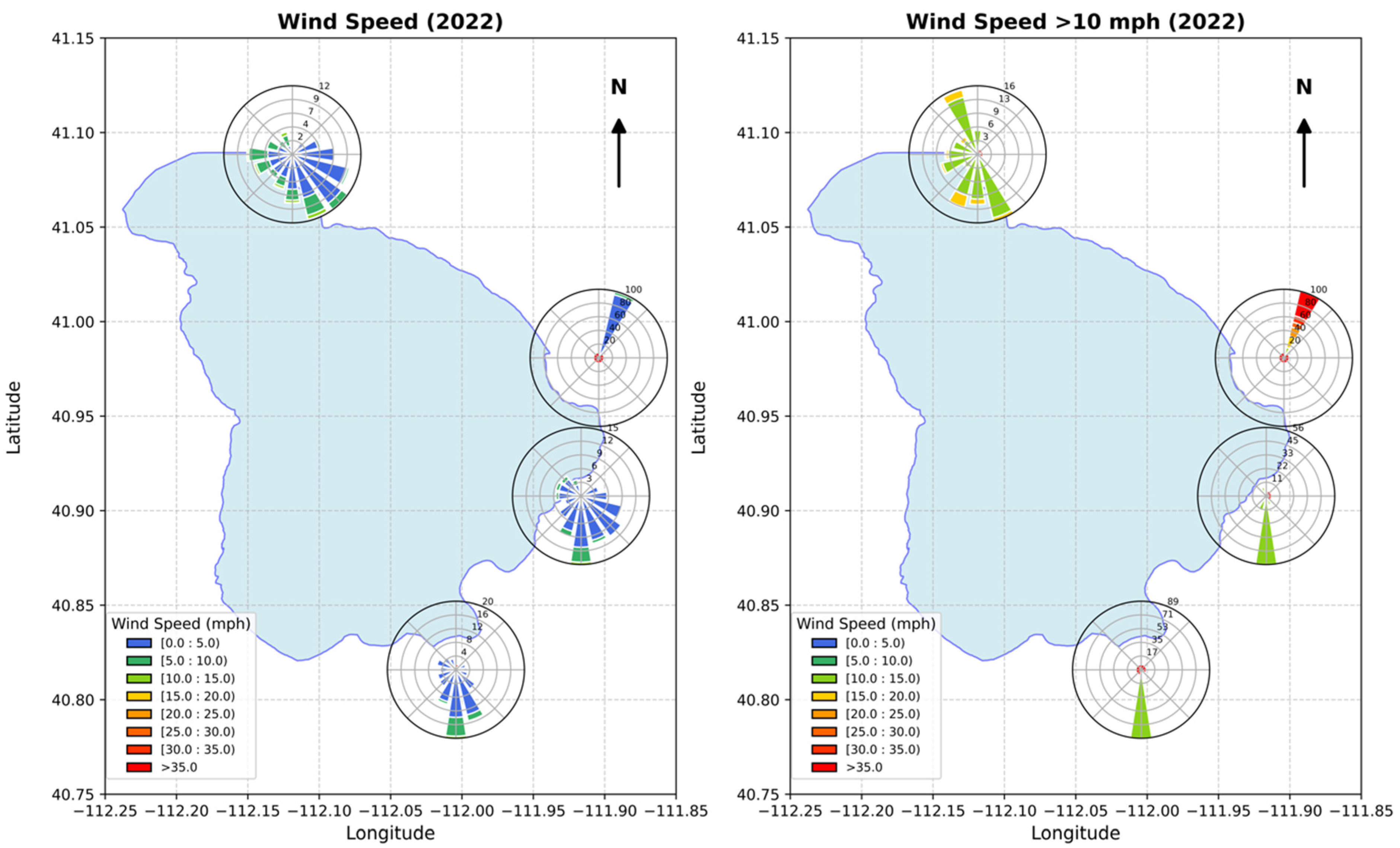
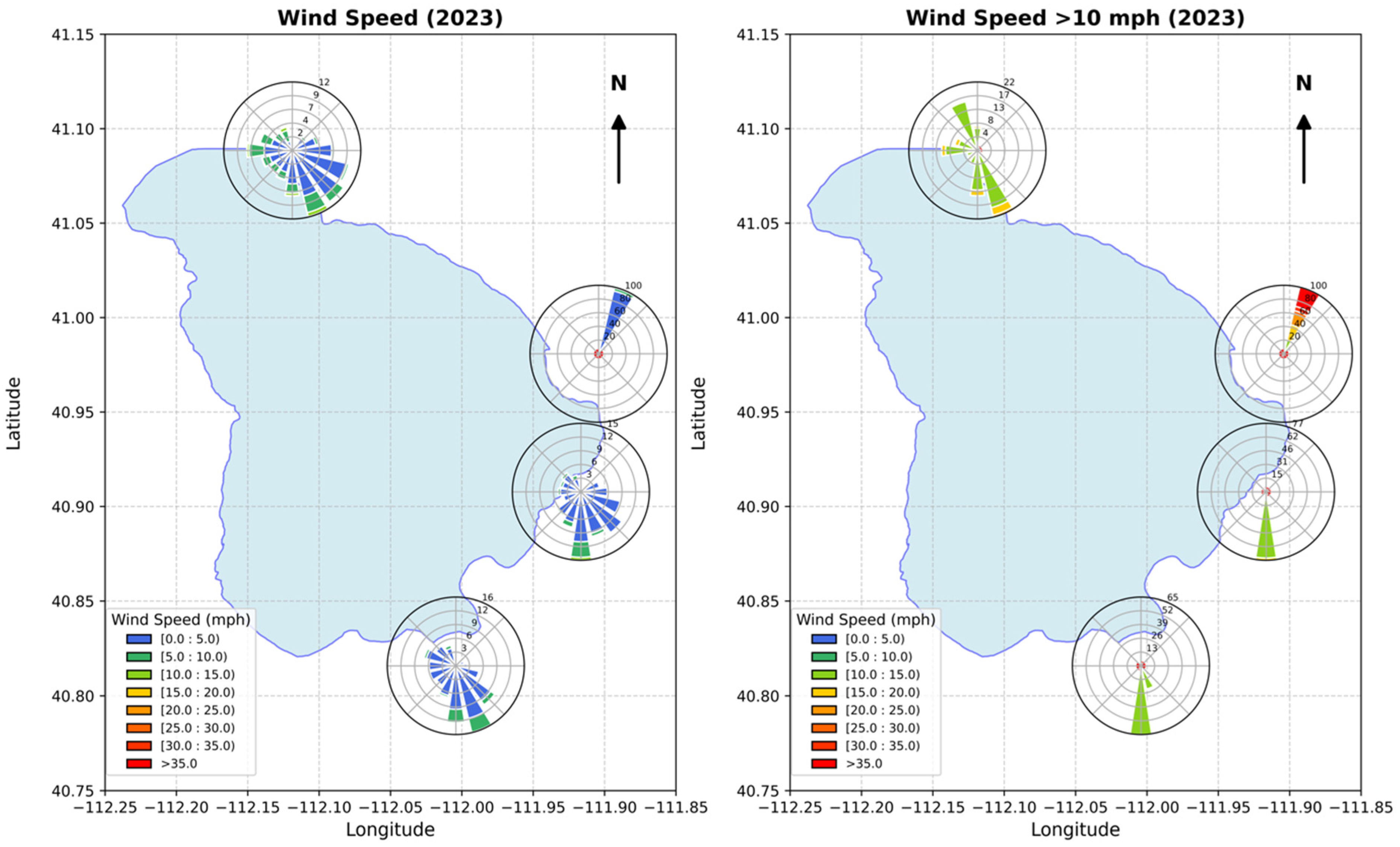
References
- Bennett, M.G.; Schofield, K.A.; Lee, S.S.; Norton, S.B. Response of Chlorophyll a to Total Nitrogen and Total Phosphorus Concentrations in Lotic Ecosystems: A Systematic Review Protocol. Environ. Evid. 2017, 6, 18. [Google Scholar] [CrossRef] [PubMed]
- Komala, P.S.; Primasari, B.; Ayunin, Q. The Influence of the Physicochemical Parameters on the Ortho Phosphate and Total Phosphate Concentrations of Maninjau Lake. J. Phys. Conf. Ser. 2020, 1625, 012061. [Google Scholar] [CrossRef]
- Blaas, H.; Kroeze, C. Excessive Nitrogen and Phosphorus in European Rivers: 2000–2050. Ecol. Indic. 2016, 67, 328–337. [Google Scholar] [CrossRef]
- Dabrowski, J.M. Applying SWAT to Predict Ortho-Phosphate Loads and Trophic Status in Four Reservoirs in the Upper Olifants Catchment, South Africa. Hydrol. Earth Syst. Sci. 2014, 18, 2629–2643. [Google Scholar] [CrossRef]
- Hillery, B.R.; Simcik, M.F.; Basu, I.; Hoff, R.M.; Strachan, W.M.J.; Burniston, D.; Chan, C.H.; Brice, K.A.; Sweet, C.W.; Hites, R.A. Atmospheric Deposition of Toxic Pollutants to the Great Lakes As Measured by the Integrated Atmospheric Deposition Network. Environ. Sci. Technol. 1998, 32, 2216–2221. [Google Scholar] [CrossRef]
- Koszelnik, P. Atmospheric Deposition as a Source of Nitrogen and Phosphorus Loads into the Rzeszów Reservoir, SE Poland. Environ. Prot. Eng. 2007, 33, 157. [Google Scholar]
- Zheng, T.; Cao, H.; Liu, W.; Xu, J.; Yan, Y.; Lin, X.; Huang, J. Characteristics of Atmospheric Deposition during the Period of Algal Bloom Formation in Urban Water Bodies. Sustainability 2019, 11, 1703. [Google Scholar] [CrossRef]
- Guieu, C.; Aumont, O.; Paytan, A.; Bopp, L.; Law, C.S.; Mahowald, N.; Achterberg, E.P.; Marañón, E.; Salihoglu, B.; Crise, A.; et al. The Significance of the Episodic Nature of Atmospheric Deposition to Low Nutrient Low Chlorophyll Regions. Glob. Biogeochem. Cycles 2014, 28, 1179–1198. [Google Scholar] [CrossRef]
- Donaghay, P.L.; Liss, P.S.; Duce, R.A.; Kester, D.R.; Hanson, A.K. The Role of Episodic Atmospheric Nutrient Inputs in the Chemical and Biological Dynamics of Oceanic Ecosystems. Oceanography 2015, 4, 62–70. [Google Scholar] [CrossRef]
- Loÿe-Pilot, M.D.; Martin, J.M. Saharan Dust Input to the Western Mediterranean: An Eleven Years Record in Corsica. In The Impact of Desert Dust Across the Mediterranean; Guerzoni, S., Chester, R., Eds.; Springer: Dordrecht, The Netherlands, 1996; pp. 191–199. ISBN 978-94-017-3354-0. [Google Scholar]
- Guerzoni, S.; Chester, R.; Dulac, F.; Herut, B.; Loÿe-Pilot, M.-D.; Measures, C.; Migon, C.; Molinaroli, E.; Moulin, C.; Rossini, P.; et al. The Role of Atmospheric Deposition in the Biogeochemistry of the Mediterranean Sea. Prog. Oceanogr. 1999, 44, 147–190. [Google Scholar] [CrossRef]
- Bonnet, S.; Guieu, C. Atmospheric Forcing on the Annual Iron Cycle in the Western Mediterranean Sea: A 1-Year Survey. J. Geophys. Res. Oceans 2006, 111, C09010. [Google Scholar] [CrossRef]
- Guieu, C.; Dulac, F.; Desboeufs, K.; Wagener, T.; Pulido-Villena, E.; Grisoni, J.-M.; Louis, F.; Ridame, C.; Blain, S.; Brunet, C.; et al. Large Clean Mesocosms and Simulated Dust Deposition: A New Methodology to Investigate Responses of Marine Oligotrophic Ecosystems to Atmospheric Inputs. Biogeosciences 2010, 7, 2765–2784. [Google Scholar] [CrossRef]
- Ternon, E.; Guieu, C.; Loÿe-Pilot, M.-D.; Leblond, N.; Bosc, E.; Gasser, B.; Miquel, J.-C.; Martín, J. The Impact of Saharan Dust on the Particulate Export in the Water Column of the North Western Mediterranean Sea. Biogeosciences 2010, 7, 809–826. [Google Scholar] [CrossRef]
- Olsen, J.M.; Williams, G.P.; Miller, A.W.; Merritt, L. Measuring and Calculating Current Atmospheric Phosphorous and Nitrogen Loadings to Utah Lake Using Field Samples and Geostatistical Analysis. Hydrology 2018, 5, 45. [Google Scholar] [CrossRef]
- Barrus, S.M.; Williams, G.P.; Miller, A.W.; Borup, M.B.; Merritt, L.B.; Richards, D.C.; Miller, T.G. Nutrient Atmospheric Deposition on Utah Lake: A Comparison of Sampling and Analytical Methods. Hydrology 2021, 8, 123. [Google Scholar] [CrossRef]
- Brown, M.M.; Telfer, J.T.; Williams, G.P.; Miller, A.W.; Sowby, R.B.; Hales, R.C.; Tanner, K.B. Nutrient Loadings to Utah Lake from Precipitation-Related Atmospheric Deposition. Hydrology 2023, 10, 200. [Google Scholar] [CrossRef]
- Gaichuk, I.V.; Finley, H. Groundwater Nutrient Fluxes and Hydrological Dynamics in the Farmington Bay Wetlands. Master’s Thesis, The University of Utah, Salt Lake City, UT, USA, 2023. [Google Scholar]
- Gunnell, N.V. A Study of the Anthropogenic Impact in Farmington Bay through Isotopic and Elemental Analysis. Master’s Thesis, Brigham Young University, Provo, UT, USA, 2020. [Google Scholar]
- Wurtsba, W.; Richards, C.; Hodson, J.; Rasmussen, C.; Winter, C. Biotic and Chemical Changes Along the Salinity Gradient in Farmington Bay, Great Salt Lake; Utah State University, Utah Division of Water Quality: Logan, UT, USA, 2015. [Google Scholar]
- Wurtsbaugh, W.; Marcarelli, A. Eutrophication in Farmington Bay, Great Salt Lake, Utah 2005 Annual Report; Utah State University: Logan, UT, USA, 2005. [Google Scholar]
- Armstrong, T.; Wurtsbaugh, W.A. Impacts of Eutrophication on Benthic Invertebrates & Fish Prey of Birds in Farmington and Bear River Bays of Great Salt Lake; Watershed Sciences Faculty Publications; Utah State University: Logan, UT, USA, 2019; p. 41. [Google Scholar]
- Wurtsbaugh, W.; Marcarelli, A.M.; Christison, C.; Moore, J.; Gross, D.; Bates, S.; Kircher, S.J. Comparative Analysis of Pollution in Farmington Bay and the Great Salt Lake, Utah; Watershed Sciences Faculty Publications; Utah State University: Logan, UT, USA, 2002. [Google Scholar]
- Peretti, M.; Piñeiro, G.; Fernández Long, M.E.; Carnelos, D.A. Influence of the Precipitation Interval on Wet Atmospheric Deposition. Atmos. Environ. 2020, 237, 117580. [Google Scholar] [CrossRef]
- Stevenazzi, S.; Camera, C.A.S.; Masetti, M.; Azzoni, R.S.; Ferrari, E.S.; Tiepolo, M. Atmospheric Nitrogen Depositions in a Highly Human-Impacted Area. Water Air Soil Pollut. 2020, 231, 276. [Google Scholar] [CrossRef]
- Tarboton, D.; Merck, M. Great Salt Lake Bathymetry, Hydroshare. 2023. Available online: http://www.hydroshare.org/resource/582060f00f6b443bb26e896426d9f62a (accessed on 10 November 2024).
- Mitchell, L.E.; Zajchowski, C.A.B. The History of Air Quality in Utah: A Narrative Review. Sustainability 2022, 14, 9653. [Google Scholar] [CrossRef]
- Hansen, J.C.; Woolwine, W.R., III.; Bates, B.L.; Clark, J.M.; Kuprov, R.Y.; Mukherjee, P.; Murray, J.A.; Simmons, M.A.; Waite, M.F.; Eatough, N.L.; et al. Semicontinuous PM2.5 and PM10 Mass and Composition Measurements in Lindon, Utah, during Winter 2007. J. Air Waste Manag. Assoc. 2010, 60, 346–355. [Google Scholar] [CrossRef]
- Horel, J.D.; Powell, J.T. Analysis and Prediction of Summer Rainfall over Southwestern Utah. Weather Forecast. 2024, 39, 1007–1021. [Google Scholar] [CrossRef]
- Sainani, K.L. Dealing with Non-Normal Data. PM&R 2012, 4, 1001–1005. [Google Scholar] [CrossRef]
- Yu, X.; Wong, Y.K.; Yu, J.Z. Abundance and Sources of Organic Nitrogen in Fine (PM2.5) and Coarse (PM2.5–10) Particulate Matter in Urban Hong Kong. Sci. Total Environ. 2023, 901, 165880. [Google Scholar] [CrossRef] [PubMed]
- Meng, Y.; Li, R.; Fu, H.; Bing, H.; Huang, K.; Wu, Y. The Sources and Atmospheric Pathway of Phosphorus to a High Alpine Forest in Eastern Tibetan Plateau, China. J. Geophys. Res. Atmos. 2020, 125, e2019JD031327. [Google Scholar] [CrossRef]
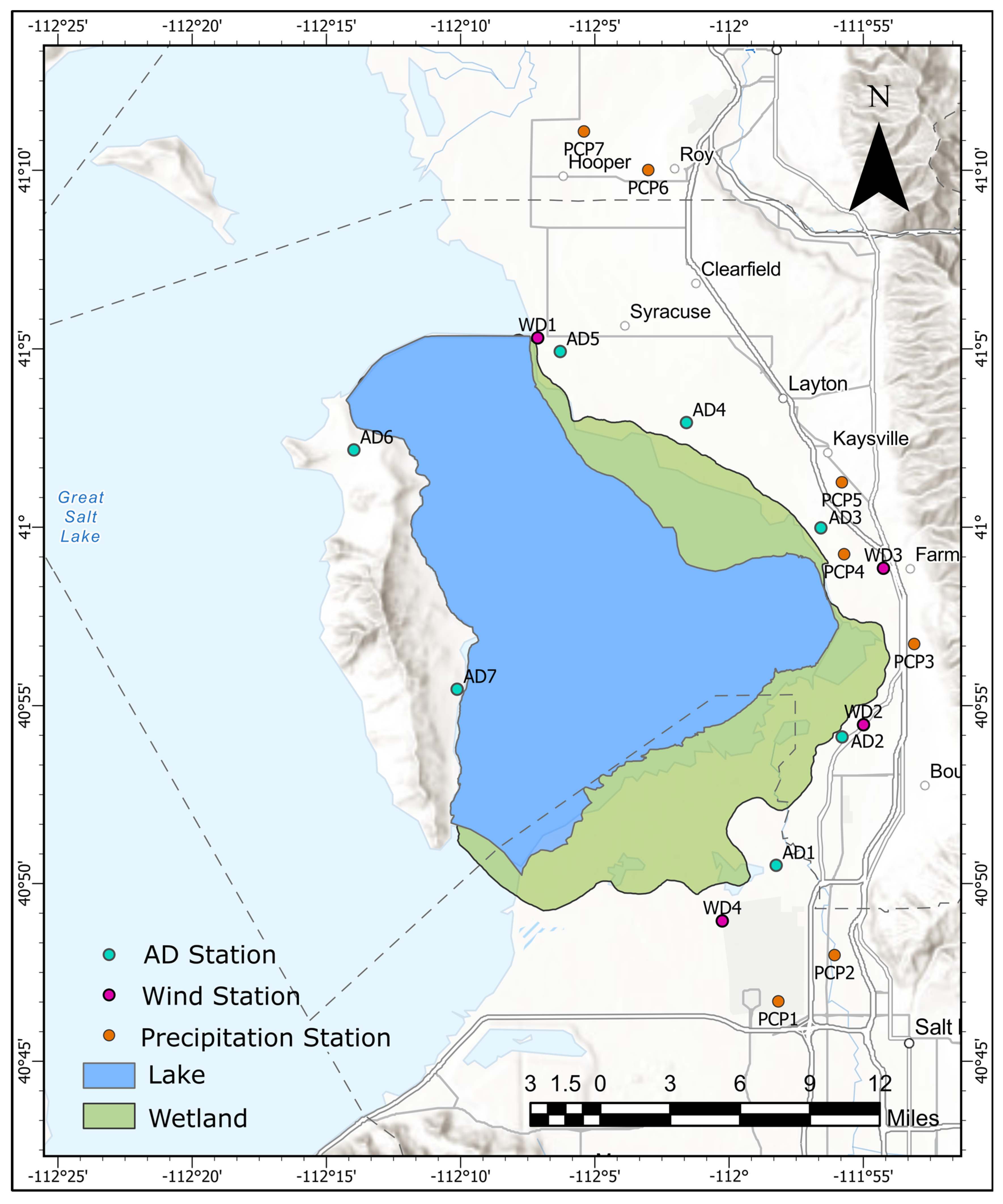
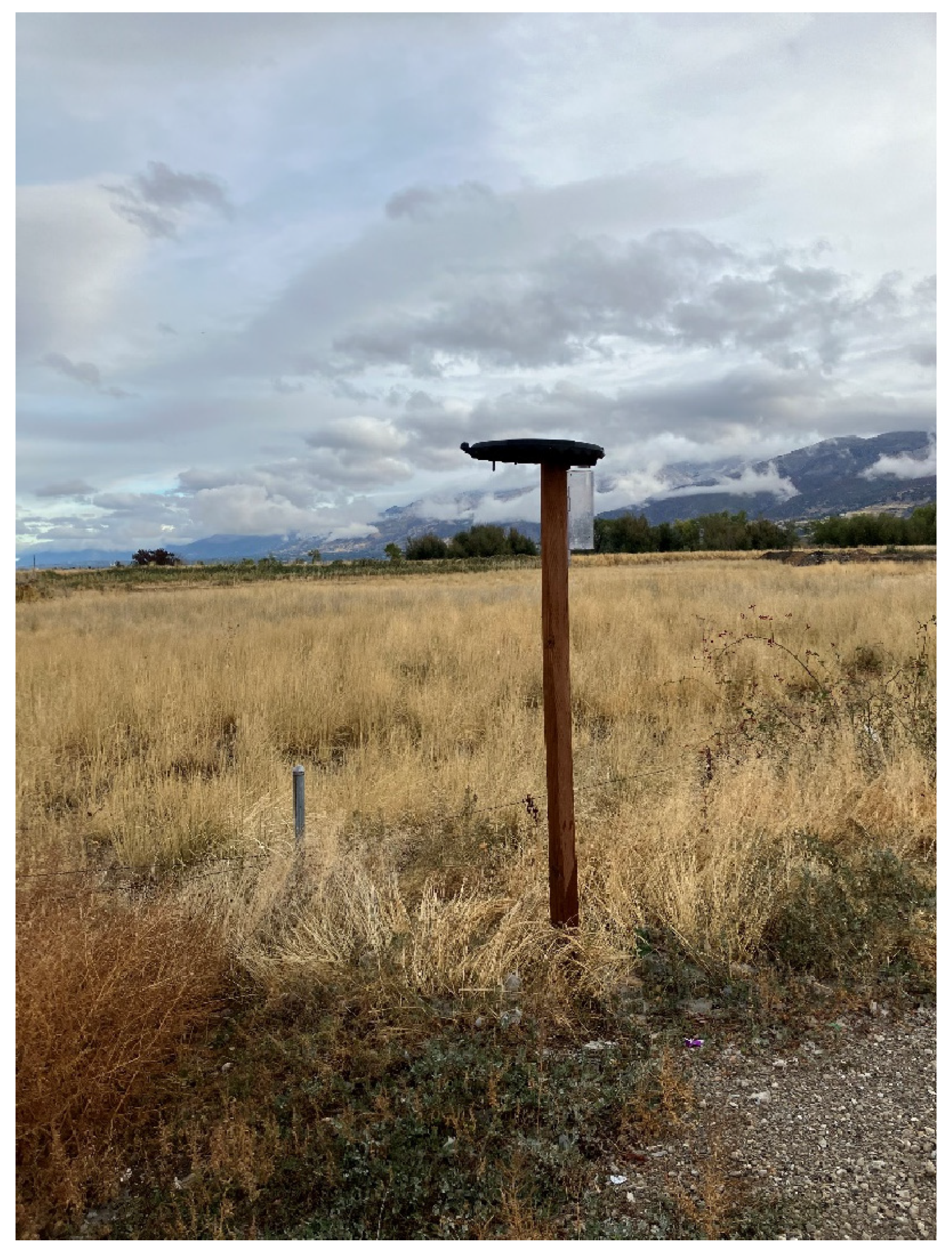

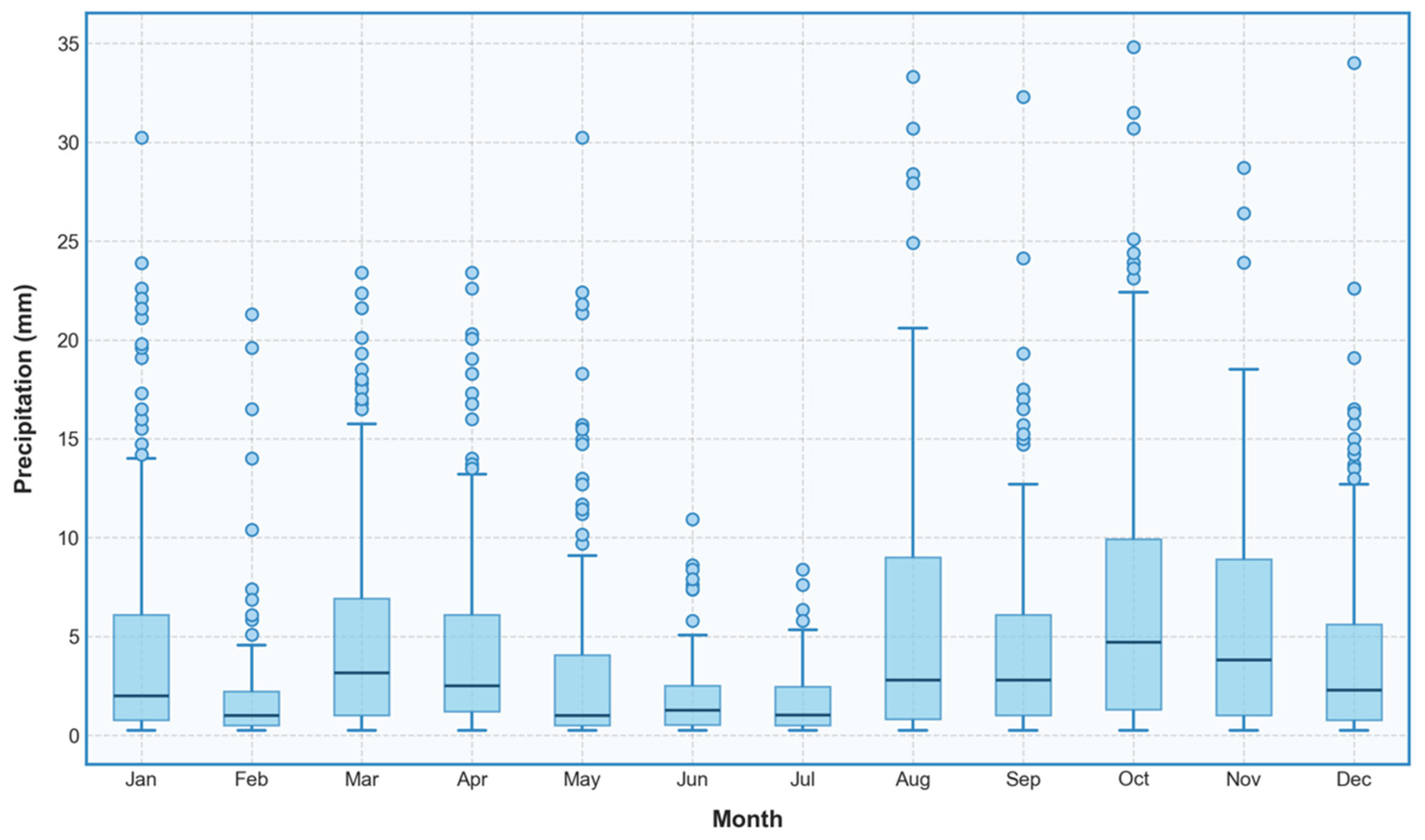
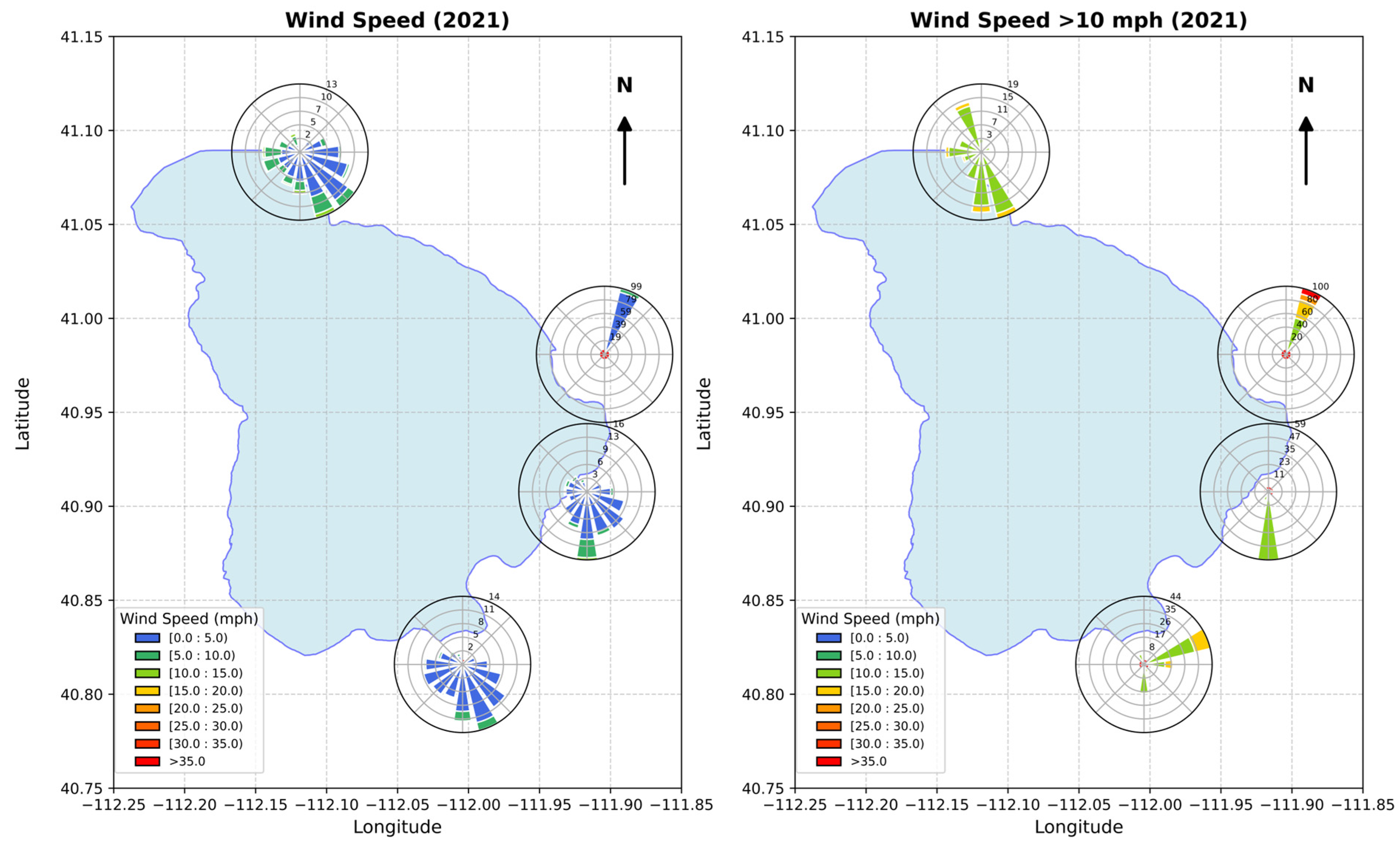

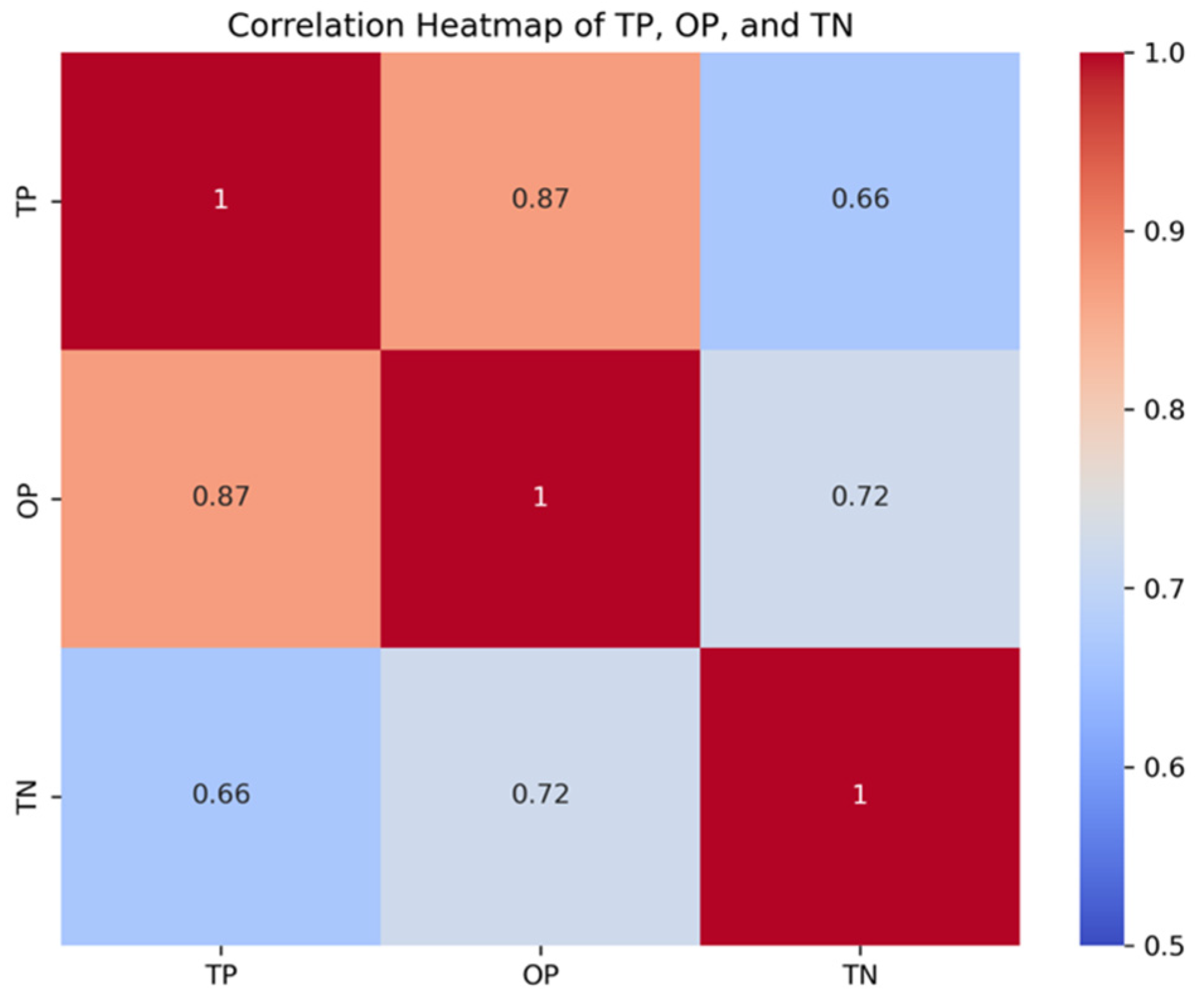
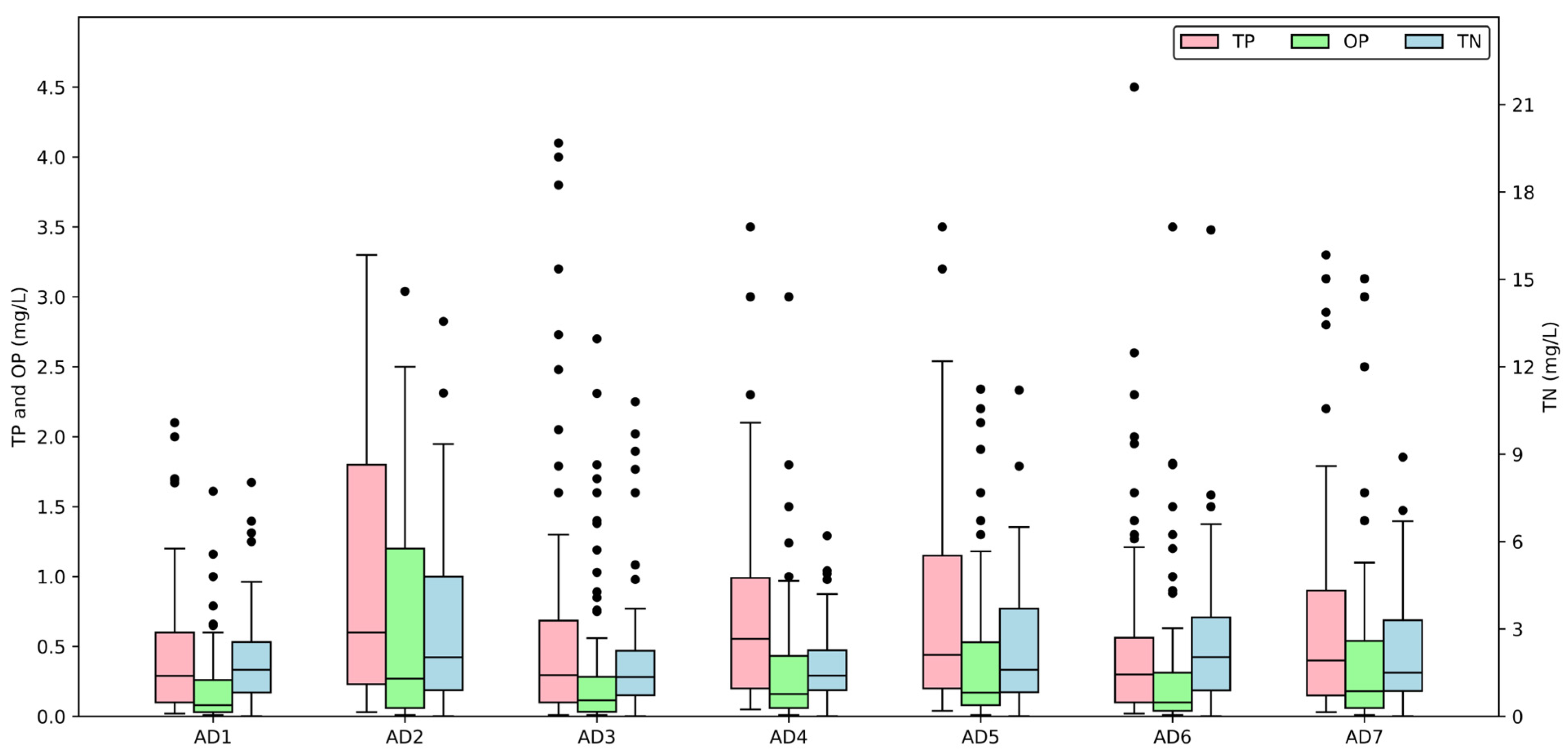
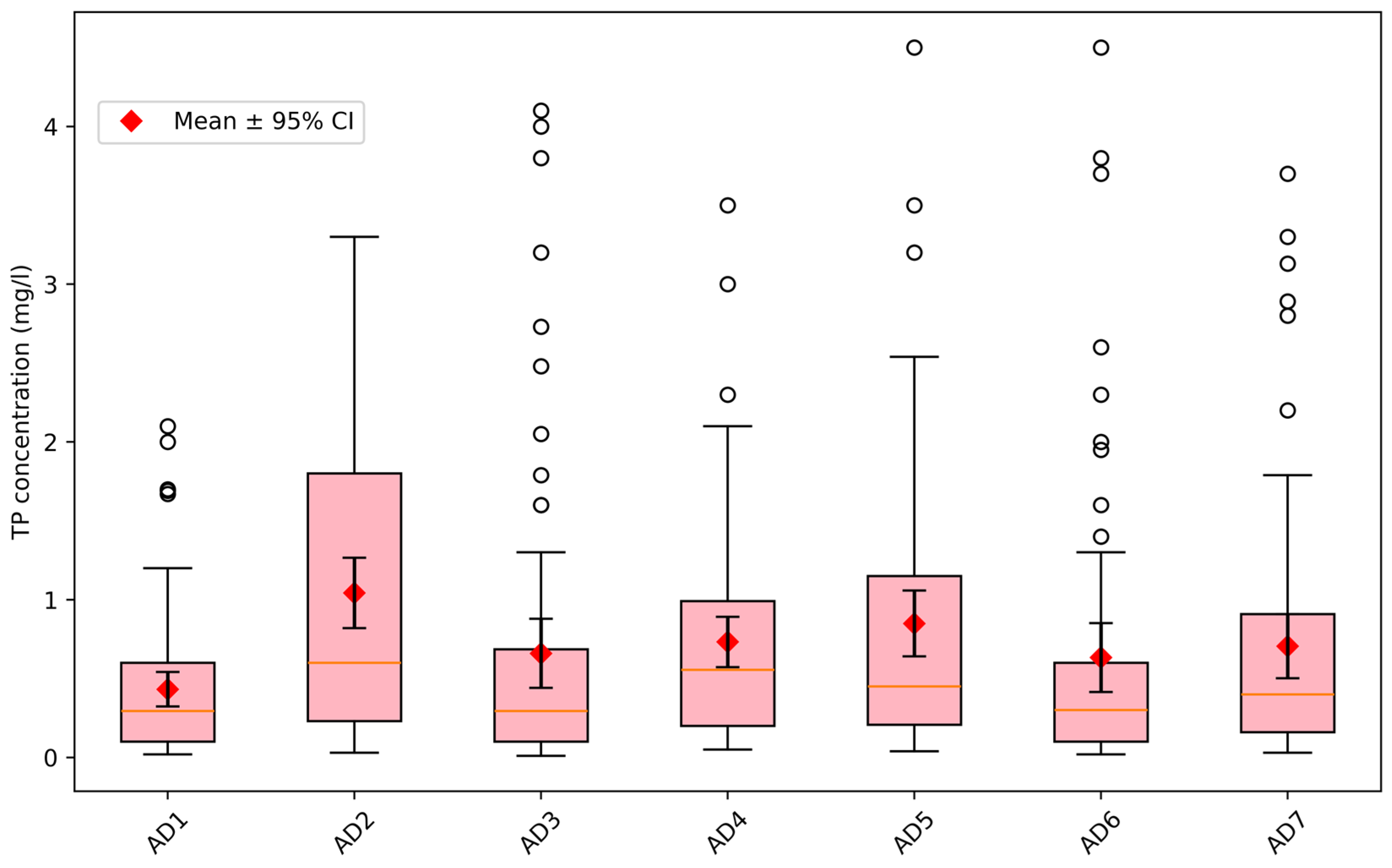
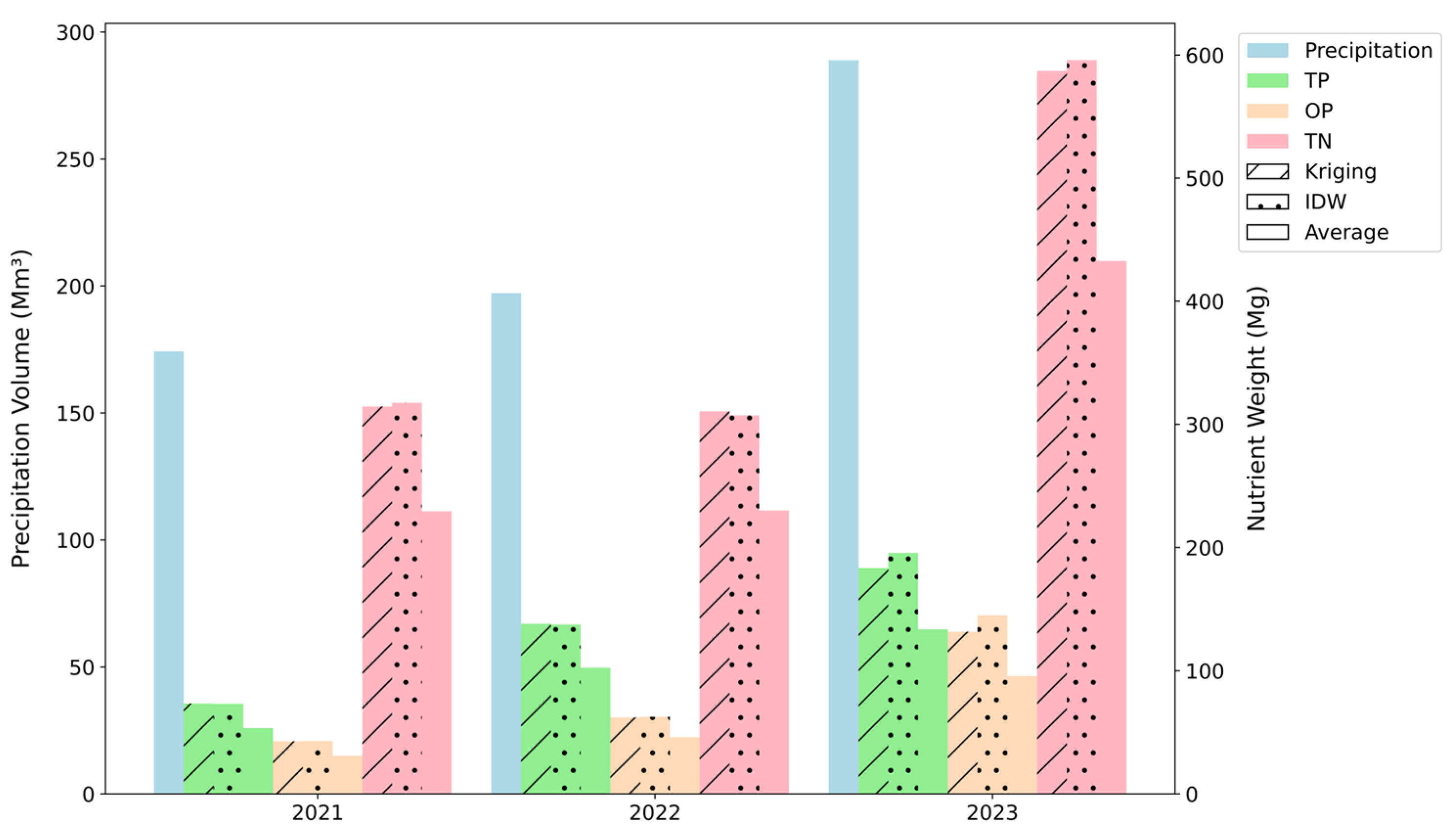
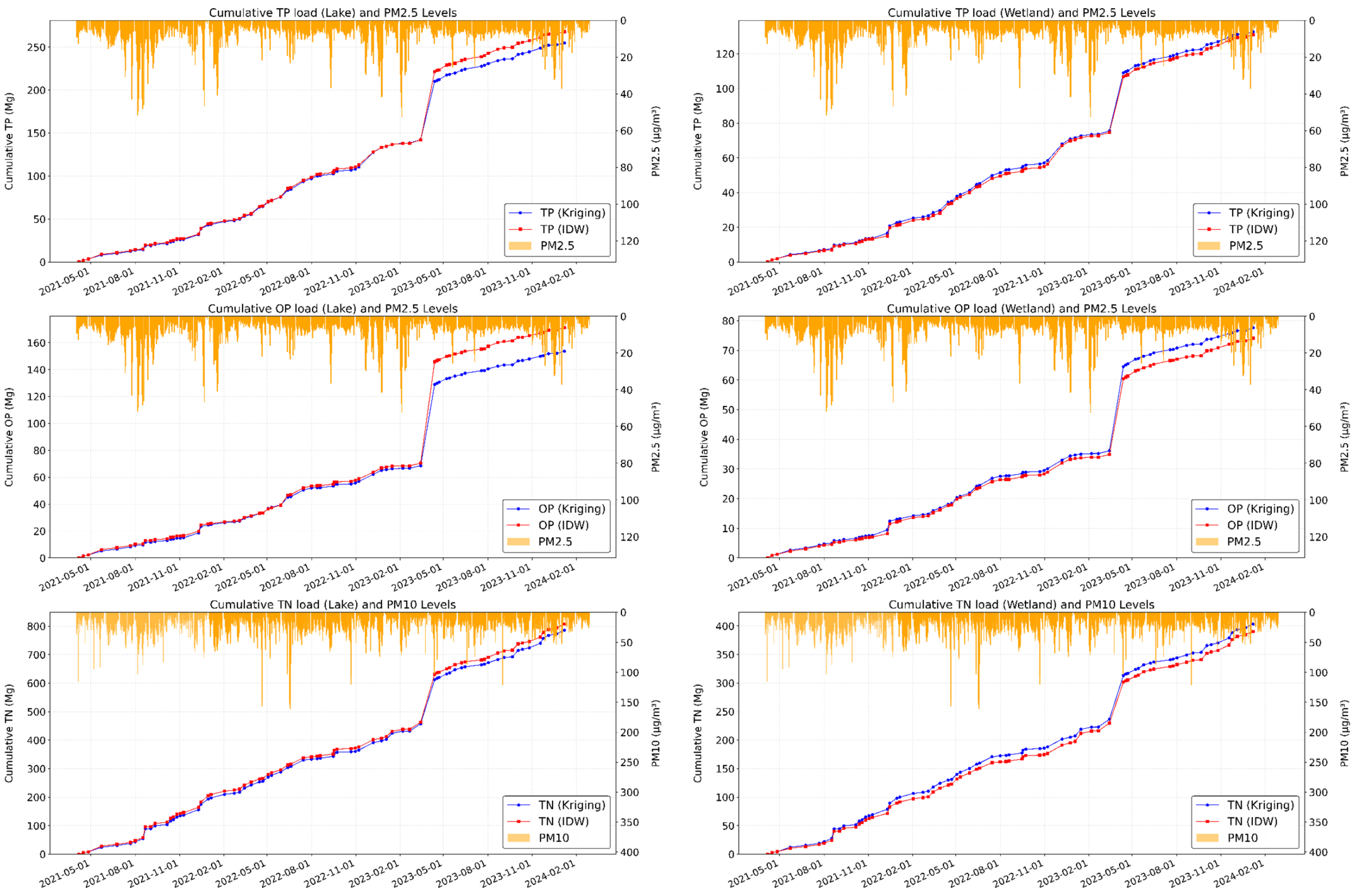
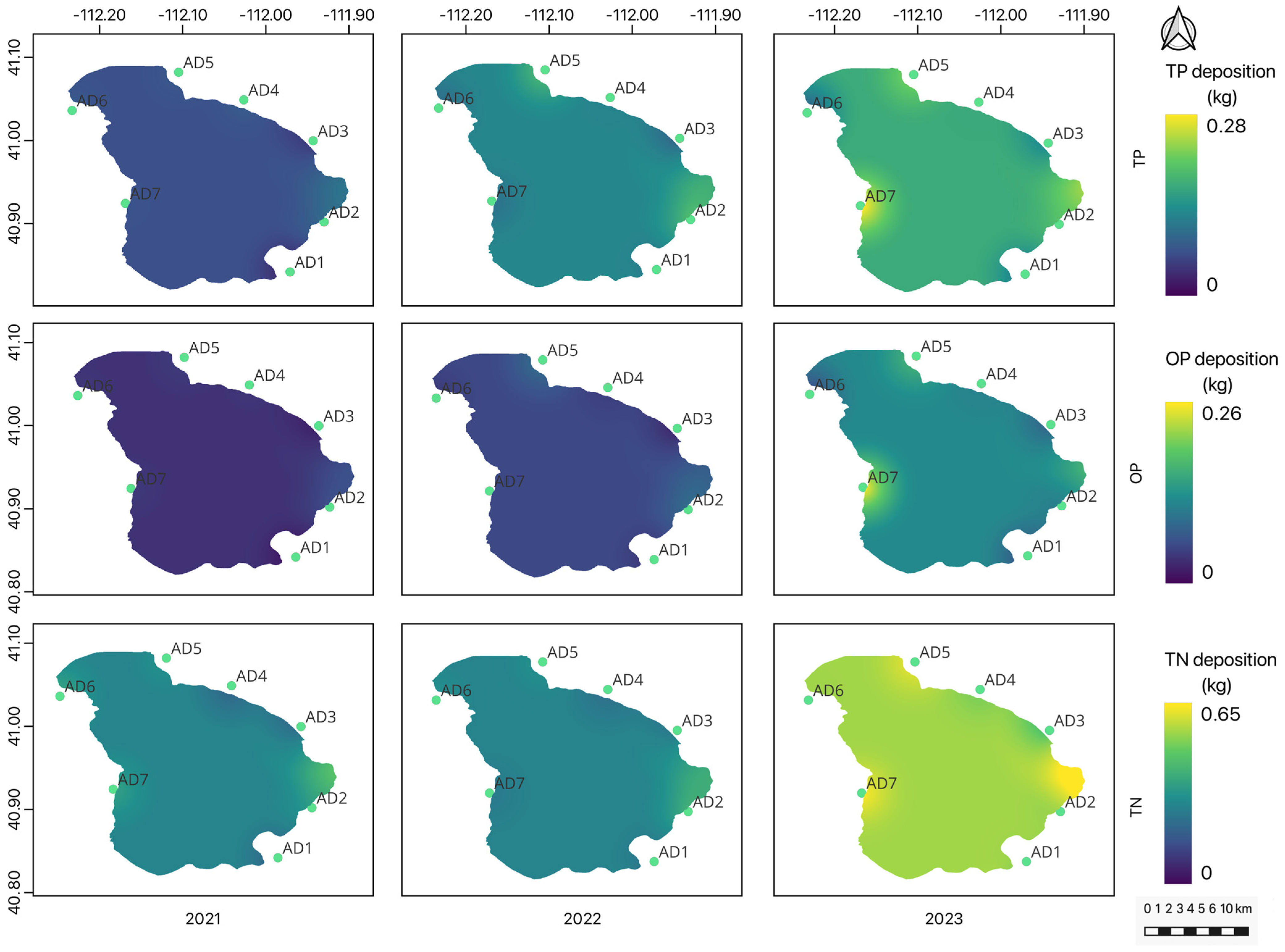
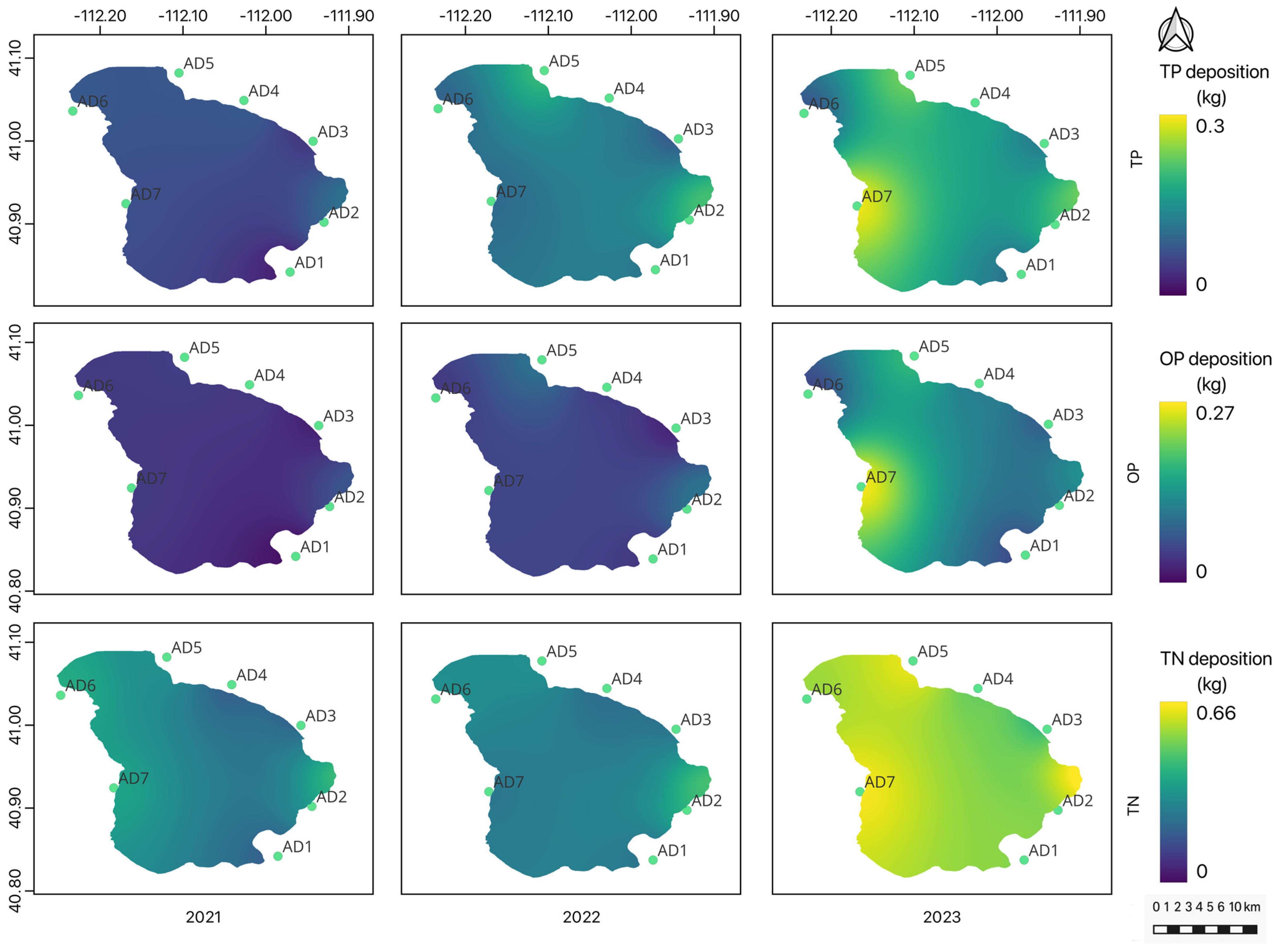
| Station Index | Name | Latitude | Longitude |
|---|---|---|---|
| AD1 | Gillmor Farm | 40.842 | −111.971 |
| AD2 | South Davis | 40.902 | −111.930 |
| AD3 | Central Davis | 41.000 | −111.943 |
| AD4 | GSL Preserve | 41.049 | −112.026 |
| AD5 | North Davis | 41.082 | −112.105 |
| AD6 | Buffalo Pens | 41.036 | −112.233 |
| AD7 | Garr Ranch | 40.924 | −112.169 |
| Station Index | Station Name | Latitude | Longitude | Elevation (m) | Network |
|---|---|---|---|---|---|
| PCP1 | Salt Lake City Intl Ap | 40.778 | −111.969 | 1288 | GHCN |
| PCP2 | Rose Park | 40.800 | −111.935 | 1287 | MCHD |
| PCP3 | Centerville 1.3 N | 40.945 | −111.885 | 1300 | CoCoRaHS |
| PCP4 | Farmington 1.8 W | 40.987 | −111.929 | 1292 | GHCN |
| PCP5 | Kaysville—USU Farm | 41.021 | −111.930 | 1372 | MCHD |
| PCP6 | Eagle Lake | 41.167 | −112.050 | 1334 | MCHD |
| PCP7 | West Haven 2.0 SW | 41.185 | −112.090 | 1292 | GHCN |
| Station Index | Station Name | Station ID | Latitude | Longitude | Elevation (m) | Network |
|---|---|---|---|---|---|---|
| WD1 | Syracuse | UUSYR | 41.088 | −112.119 | 1285 | MESOWEST |
| WD2 | Legacy Parkway | UTLGP | 40.908 | −111.917 | 1284 | MESOWEST |
| WD3 | KJ7NO-2 Farmington | AP611 | 40.981 | −111.904 | 1290 | MESOWEST |
| WD4 | SLC Airport Wind 2 | SLCNW | 40.816 | −112.004 | 1304 | MESOWEST |
| Nutrient | Station Index | Number of samples | Mean (mg/L) | Median (mg/L) | Max (mg/L) | Skew |
|---|---|---|---|---|---|---|
| TP | AD1 | 74 | 0.43 | 0.30 | 2.10 | 1.88 |
| AD2 | 73 | 1.04 | 0.60 | 3.30 | 0.80 | |
| AD3 | 74 | 0.66 | 0.30 | 4.10 | 2.29 | |
| AD4 | 74 | 0.73 | 0.55 | 3.50 | 1.72 | |
| AD5 | 74 | 0.85 | 0.45 | 4.50 | 1.77 | |
| AD6 | 70 | 0.63 | 0.30 | 4.50 | 2.52 | |
| AD7 | 70 | 0.71 | 0.40 | 3.70 | 1.89 | |
| OP | AD1 | 74 | 0.21 | 0.08 | 1.61 | 2.51 |
| AD2 | 73 | 0.67 | 0.27 | 3.04 | 1.09 | |
| AD3 | 74 | 0.35 | 0.11 | 2.70 | 2.36 | |
| AD4 | 74 | 0.34 | 0.16 | 3.00 | 3.09 | |
| AD5 | 73 | 0.42 | 0.17 | 2.34 | 1.98 | |
| AD6 | 68 | 0.34 | 0.10 | 3.50 | 3.27 | |
| AD7 | 69 | 0.43 | 0.18 | 3.13 | 2.64 | |
| TN | AD1 | 73 | 1.90 | 1.60 | 8.03 | 1.73 |
| AD2 | 74 | 3.24 | 2.04 | 13.56 | 1.34 | |
| AD3 | 75 | 2.14 | 1.40 | 12.90 | 2.49 | |
| AD4 | 74 | 1.79 | 1.40 | 6.20 | 1.24 | |
| AD5 | 73 | 2.37 | 1.60 | 11.20 | 1.60 | |
| AD6 | 71 | 2.82 | 2.11 | 16.70 | 2.65 | |
| AD7 | 70 | 2.53 | 1.55 | 13.70 | 2.00 |
| Station Index | Mean | Tukey-Kramer HSD | Student’s t-Test | |||
|---|---|---|---|---|---|---|
| AD2 | 1.04 | A | A | |||
| AD6 | 0.84 | A | A | B | ||
| AD7 | 0.73 | A | B | B | ||
| AD5 | 0.70 | A | B | B | ||
| AD3 | 0.65 | A | B | B | C | |
| AD4 | 0.63 | B | B | C | ||
| AD1 | 0.43 | B | C | |||
| 2021 | 2022 | 2023 | |||||||
|---|---|---|---|---|---|---|---|---|---|
| Kriging (Mg) | IDW (Mg) | Avg (Mg) | Kriging (Mg) | IDW (Mg) | Avg (Mg) | Kriging (Mg) | IDW (Mg) | Avg (Mg) | |
| TP | 73.3 | 73.2 | 53.4 | 138.2 | 137.5 | 102.5 | 183.2 | 195.5 | 133.6 |
| OP | 42.6 | 42.8 | 31.0 | 62.0 | 62.6 | 45.9 | 131.6 | 145.0 | 95.8 |
| TN | 314.5 | 317.5 | 229.4 | 310.7 | 307.3 | 230.1 | 587.0 | 595.8 | 432.8 |
Disclaimer/Publisher’s Note: The statements, opinions and data contained in all publications are solely those of the individual author(s) and contributor(s) and not of MDPI and/or the editor(s). MDPI and/or the editor(s) disclaim responsibility for any injury to people or property resulting from any ideas, methods, instructions or products referred to in the content. |
© 2025 by the authors. Licensee MDPI, Basel, Switzerland. This article is an open access article distributed under the terms and conditions of the Creative Commons Attribution (CC BY) license (https://creativecommons.org/licenses/by/4.0/).
Share and Cite
Williams, G.P.; Miller, A.W.; Aghababaei, A.; Chapagain, A.R.; Wagle, P.; Baaniya, Y.; Magoffin, R.H.; Li, X.; Miskin, T.; Oldham, P.D.; et al. Precipitation-Related Atmospheric Nutrient Deposition in Farmington Bay: Analysis of Spatial and Temporal Patterns. Hydrology 2025, 12, 131. https://doi.org/10.3390/hydrology12060131
Williams GP, Miller AW, Aghababaei A, Chapagain AR, Wagle P, Baaniya Y, Magoffin RH, Li X, Miskin T, Oldham PD, et al. Precipitation-Related Atmospheric Nutrient Deposition in Farmington Bay: Analysis of Spatial and Temporal Patterns. Hydrology. 2025; 12(6):131. https://doi.org/10.3390/hydrology12060131
Chicago/Turabian StyleWilliams, Gustavious P., A. Woodruff Miller, Amin Aghababaei, Abin Raj Chapagain, Pitamber Wagle, Yubin Baaniya, Rachel H. Magoffin, Xueyi Li, Taylor Miskin, Peter D. Oldham, and et al. 2025. "Precipitation-Related Atmospheric Nutrient Deposition in Farmington Bay: Analysis of Spatial and Temporal Patterns" Hydrology 12, no. 6: 131. https://doi.org/10.3390/hydrology12060131
APA StyleWilliams, G. P., Miller, A. W., Aghababaei, A., Chapagain, A. R., Wagle, P., Baaniya, Y., Magoffin, R. H., Li, X., Miskin, T., Oldham, P. D., Oldham, S. J., Peterson, T., Prince, L., Tanner, K. B., Cardall, A. C., & Ames, D. P. (2025). Precipitation-Related Atmospheric Nutrient Deposition in Farmington Bay: Analysis of Spatial and Temporal Patterns. Hydrology, 12(6), 131. https://doi.org/10.3390/hydrology12060131








